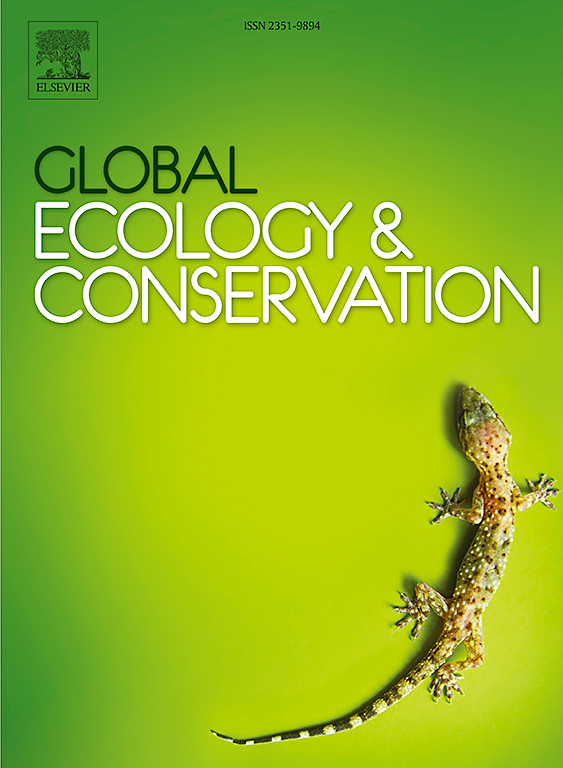鳞片贸易:对非洲内外穿山甲鳞片截获的媒体报道的分析
IF 3.4
2区 环境科学与生态学
Q1 BIODIVERSITY CONSERVATION
引用次数: 0
摘要
尽管国际贸易禁令(CITES,附录I),非洲穿山甲贸易和运输进出非洲仍然存在。三尖螯虾和巨型螯虾现已被列为濒危物种,四趾螯虾和末端螯虾已被列为世界自然保护联盟红色名录中的易危物种。迄今为止,非洲穿山甲鳞片的综合贸易数据仍然缺乏。在这里,我们分析了2016年至2024年间来自社交媒体、穿山甲组织和在线新闻媒体的与非洲相关的穿山甲拦截数据。我们报告了130起查获案件,涉及15个非洲国家和7个亚洲国家,查获非洲穿山甲鳞片287,272 公斤。总的来说,尼日利亚和刚果民主共和国是主要出口国,而中国、越南和新加坡是非洲穿山甲鳞片的主要进口国。国内截获最多的是尼日利亚、喀麦隆和乌干达,这表明它们可能是过境国。虽然缉获的数量和年份与缉获的鳞片数量和年份之间存在负相关关系,但2019年鳞片数量急剧增加(97,877 kg;34 %的数据)。此外,这两个指标在2019年之后都有所下降,拦截越来越多地局限于非洲国家。这可能反映出资源缺乏、识别穿山甲鳞片的能力低下、贩运路线随时间变化、地下贸易、执法和海关腐败。我们的研究通过关注贸易路线、缉获和进口国和出口国,为不断增长的非洲穿山甲贸易数据做出了贡献,这对有效的保护管理至关重要。本文章由计算机程序翻译,如有差异,请以英文原文为准。
Scaly trade: Analyses of the media reports of pangolin (Pholidota) scale interceptions within and out of Africa
Despite the international trade ban (CITES, Appendix I), African pangolin trade and shipping within and out of Africa persist. Phataginus tricuspis and Smutsia gigantea are now classified as Endangered, and Phataginus tetradactyla and Smutsia temminckii as Vulnerable on the IUCN Red List. To date, the comprehensive trade data of African pangolin scales is still lacking. Here we analyzed pangolin interception data linked to Africa from social media, pangolin organizations, and online news media between 2016 and 2024. We report 130 seizure incidents accounting for 287,272 kg of African pangolin scales involving 15 African and seven Asian countries. Overall, Nigeria and the Democratic Republic of Congo are major exporters, while China, Vietnam, and Singapore are the major importers of African pangolin scales. Domestic interceptions were highest in Nigeria, Cameroon, and Uganda, signifying that they may be transit countries. While there was a negative correlation between the number of seizures and years, and the quantity of scales seized and years, 2019 reported a sharp increase in quantity of scales (97,877 kg; 34 % of the data). Furthermore, both metrics declined after 2019, with interceptions increasingly confined to African countries. This could reflect lack of resources, low capacity for identifying pangolin scales, change in routes of trafficking over time, underground trade, law enforcement and customs corruption. Our study contributes to the growing body of data on the African pangolin trade by focusing on trade routes, seizures, and importer and exporter countries, which are essential for effective conservation management.
求助全文
通过发布文献求助,成功后即可免费获取论文全文。
去求助
来源期刊

Global Ecology and Conservation
Agricultural and Biological Sciences-Ecology, Evolution, Behavior and Systematics
CiteScore
8.10
自引率
5.00%
发文量
346
审稿时长
83 days
期刊介绍:
Global Ecology and Conservation is a peer-reviewed, open-access journal covering all sub-disciplines of ecological and conservation science: from theory to practice, from molecules to ecosystems, from regional to global. The fields covered include: organismal, population, community, and ecosystem ecology; physiological, evolutionary, and behavioral ecology; and conservation science.
 求助内容:
求助内容: 应助结果提醒方式:
应助结果提醒方式:


